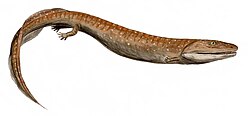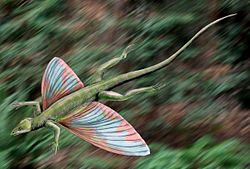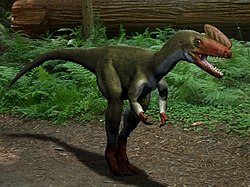Top Qs
Timeline
Chat
Perspective
1926 in paleontology
From Wikipedia, the free encyclopedia
Remove ads
Paleontology or palaeontology is the study of prehistoric life forms on Earth through the examination of plant and animal fossils.[1] This includes the study of body fossils, tracks (ichnites), burrows, cast-off parts, fossilised feces (coprolites), palynomorphs and chemical residues. Because humans have encountered fossils for millennia, paleontology has a long history both before and after becoming formalized as a science. This article records significant discoveries and events related to paleontology that occurred or were published in the year 1926.
Remove ads
Algae
Summarize
Perspective
Bacillariophyceae
More information Name, Novelty ...
| Name | Novelty | Status | Authors | Age | Unit | Location | Notes | Images |
|---|---|---|---|---|---|---|---|---|
|
Cymbella partita[2] |
sp nov |
Mann |
Latah Formation |
A cymbellaceous diatom |
 | |||
|
Cymbella sagittarius[2] |
sp nov |
Mann |
Latah Formation |
A cymbellaceous diatom |
 | |||
|
Navicula contendens[2] |
sp nov |
Mann |
Latah Formation |
A naviculaceous diatom |
 | |||
|
Navicula iridescens[2] |
sp nov |
jr synonym |
Mann |
Latah Formation |
A naviculaceous diatom |
 | ||
|
Navicula pauper[2] |
sp nov |
Mann |
Latah Formation |
A naviculaceous diatom |
 | |||
|
Navicula pontifica[2] |
sp nov |
Mann |
Latah Formation |
A naviculaceous diatom |
 | |||
|
Navicula protrudens[2] |
sp nov |
Mann |
Latah Formation |
A naviculaceous diatom |
 | |||
|
Navicula pseudoaffinis[2] |
sp nov |
Mann |
Latah Formation |
A naviculaceous diatom |
 | |||
|
Navicula reversa[2] |
sp nov |
Mann |
Latah Formation |
A naviculaceous diatom |
 | |||
|
Navicula substauroneis[2] |
sp nov |
Mann |
Latah Formation |
A naviculaceous diatom |
 | |||
|
Stauroneis (Navicula) acutissima[2] |
sp nov |
Mann |
Latah Formation |
A stauroneidaceous diatom |
 | |||
Close
Remove ads
Plants
Summarize
Perspective
Mosses
More information Name, Novelty ...
| Name | Novelty | Status | Authors | Age | Unit | Location | Notes | Images |
|---|---|---|---|---|---|---|---|---|
|
Archaeomnium[3] |
Gen et sp nov |
jr synonym |
Latah Formation |
A moss of uncertain affiliation |
 | |||
|
Polytrichites[3] |
Gen et sp nov |
valid? |
Latah Formation |
A possible polytrichaceous moss |
 | |||
Close
Lycopods
More information Name, Novelty ...
| Name | Novelty | Status | Authors | Age | Unit | Location | Notes | Images |
|---|---|---|---|---|---|---|---|---|
|
Lycopodium hesperium[3] |
Sp nov |
Nomen dubium? |
Latah Formation |
A possible lycopod clubmoss |
 | |||
Close
Conifers
More information Name, Novelty ...
| Name | Novelty | Status | Authors | Age | Unit | Location | Notes | Images |
|---|---|---|---|---|---|---|---|---|
|
Libocedrus praedecurrens[3] |
Sp nov |
jr synonym |
Latah Formation |
A sandarac species |
 | |||
|
Tumion bonseri[3] |
Sp nov |
jr synonym |
Latah Formation |
A plum-yew species |
 | |||
Close
Angiosperms
Monocots
More information Name, Novelty ...
| Name | Novelty | Status | Authors | Age | Unit | Location | Notes | Images |
|---|---|---|---|---|---|---|---|---|
|
Arisaema hesperia[3] |
Sp nov |
valid? |
Latah Formation |
A possible araceous monocot |
 | |||
|
Canna? dawsoni[8] |
Sp nov |
jr synonym |
Burrard Formation |
A possible cannaceous leaf species |
||||
Close
Basal eudicots
More information Name, Novelty ...
| Name | Novelty | Status | Authors | Age | Unit | Location | Notes | Images |
|---|---|---|---|---|---|---|---|---|
|
Gen et comb nov |
A Trochodenraceous leaf morphogenus. |
|||||||
Close
Superasterids - basal
More information Name, Novelty ...
| Name | Novelty | Status | Authors | Age | Unit | Location | Notes | Images |
|---|---|---|---|---|---|---|---|---|
|
Diospyros andersonae[3] |
Sp nov |
Jr synonym |
Latah Formation |
A persimmon leaf species |
 | |||
|
Diospyros dawsoni[8] |
Sp nov |
Okanagan Highlands |
A persimmon leaf species |
|||||
|
Diospyros? microcalyx[3] |
Sp nov |
Jr synonym |
Latah Formation |
First named as a persimmon calyx species.[3] |
 | |||
|
Vaccinium salicoides[3] |
Sp nov |
valid? |
Latah Formation |
First named as a huckleberry leaf species |
 | |||
Close
Superrosids - Fabids
More information Name, Novelty ...
| Name | Novelty | Status | Authors | Age | Unit | Location | Notes | Images |
|---|---|---|---|---|---|---|---|---|
|
Alnus cremastogynoides[8] |
Sp nov |
Chu Chua Formation |
An alder leaf species |
|||||
|
Alnus crispoides[8] |
Sp nov |
Chu Chua Formation |
An alder leaf species |
|||||
|
Betula bryani[3] |
Sp nov |
jr synonym |
Latah Formation |
First named as a birch leaf species |
 | |||
|
Betula fairii[3] |
Sp nov |
jr synonym |
Latah Formation |
First named as a birch leaf species |
 | |||
|
Betula? largei[3] |
Sp nov |
jr synonym |
Latah Formation |
First named as a birch leaf species |
 | |||
|
Betula nanoides[3] |
Sp nov |
jr synonym |
Latah Formation |
First named as a birch leaf species |
 | |||
|
Sp nov |
jr synonym |
Chu Chua Formation |
First named as a birch leaf species |
 | ||||
|
Betula thor[3] |
Sp nov |
valid |
Latah Formation |
First named as a birch leaf species |
 | |||
|
Celastrophyllum pugetensis[8] |
Sp nov |
Burrard Formation |
A possible celastraceous leaf species |
|||||
|
Celastrus fernquisti[3] |
Sp nov |
jr synonym |
Latah Formation |
First named as a Celastrus leaf species |
 | |||
|
Cercis? spokanensis[3] |
Sp nov |
jr synonym |
Latah Formation |
First named as a redbud fruit species |
 | |||
|
Comptonia predryandroides[8] |
Sp nov |
Chu Chua Formation |
A myricaceous leaf species |
|||||
|
Ficus? johnstoni[8] |
Sp nov |
Burrard Formation |
A possible moraceous leaf species |
|||||
|
Ficus? washingtonensis[3] |
Sp nov |
jr synonym |
Latah Formation |
First named as a fig leaf species |
 | |||
|
Hicoria dawsoni[8] |
Sp nov |
jr synonym |
Chu Chua Formation |
A punitive hickory leaf species |
||||
|
Hicoria stanleyanum[8] |
comb nov |
jr synonym |
(Dawson) Berry |
Burrard Formation |
A punitive hickory leaf species |
|||
|
Juglans nigelloides[8] |
Sp nov |
Burrard Formation |
A juglandaceous leaf species |
|||||
|
Leguminosites johnstoni[8] |
Sp nov |
Burrard Formation |
A legume leaf morphospecies. |
|||||
|
Meibomites lucens[3] |
Sp nov |
jr synonym |
Latah Formation |
First named as a Meibomites leaf species |
||||
|
Sp nov |
Jr synonym |
Chu Chua Formation |
A myricaceous leaf species |
|||||
|
Populus acuminatafolia[8] |
Sp nov |
Chu Chua Formation |
A cottonwood leaf species |
|||||
|
Populus fairii[3] |
Sp nov |
jr synonym |
Latah Formation |
First named as a cottonwood leaf species |
 | |||
|
Populus heteromorpha[3] |
Sp nov |
jr synonym |
Latah Formation |
First named as a cottonwood leaf species |
 | |||
|
Populus washingtonensis[3] |
Sp nov |
jr synonym |
Latah Formation |
First named as a cottonwood leaf species |
 | |||
|
Prunus rustii[3] |
Sp nov |
jr synonym |
Latah Formation |
First named as a cherry leaf species |
 | |||
|
Quercus chaneyi[3] |
Sp nov |
jr synonym |
Latah Formation |
An oak leaf species |
 | |||
|
Quercus cognatus[3] |
Sp nov |
jr synonym |
Latah Formation |
An oak leaf species |
 | |||
|
Sp nov |
jr synonym |
Latah Formation |
An oak leaf species |
 | ||||
|
Quercus praenigra[3] |
Sp nov |
jr synonym |
Latah Formation |
An oak leaf species |
 | |||
|
Quercus rustii[3] |
Sp nov |
jr synonym |
Latah Formation |
An oak leaf species |
 | |||
|
Quercus spokanensis[3] |
Sp nov |
jr synonym |
Latah Formation |
First named as an oak leaf species |
 | |||
|
Quercus uglowi[8] |
Sp nov |
Chu Chua Formation |
A oak leaf species |
|||||
|
Rhamnus kitsilaniana[8] |
Sp nov |
Burrard Formation |
A buckthorn leaf morphospecies. |
|||||
|
Salix bryani[3] |
Sp nov |
jr synonym |
Latah Formation |
A willow leaf species |
 | |||
|
Salix inquirenda[3] |
Sp nov |
jr synonym |
Latah Formation |
A willow leaf species |
 | |||
|
Salix remotidens[3] |
Sp nov |
jr synonym |
Latah Formation |
A willow leaf species |
 | |||
|
Sophora alexanderi[3] |
Sp nov |
jr synonym |
Latah Formation |
A Sophora leaf species |
 | |||
|
Sophora spokanensis[3] |
Sp nov |
Latah Formation |
A Sophora leaf species |
 | ||||
|
Sorbus decorifolia[8] |
Sp nov |
Chu Chua Formation |
A punitive mountain ash leaf species |
|||||
|
Ulmus columbianus[8] |
sp nov |
jr homonym |
Chu Chua Formation |
An elm leaf species |
 | |||
|
Ulmus fernquisti[3] |
Sp nov |
jr synonym |
Latah Formation |
First named as an elm leaf species |
 | |||
Close
Superrosids - Malvids
More information Name, Novelty ...
| Name | Novelty | Status | Authors | Age | Unit | Location | Notes | Images |
|---|---|---|---|---|---|---|---|---|
|
Sp nov |
Valid |
Latah Formation |
A maple species |
 | ||||
|
Malva? hesperia[3] |
Sp nov |
jr synonym |
Latah Formation |
First named as a possible mallow fruit species |
 | |||
Close
Angiosperms - other
More information Name, Novelty ...
| Name | Novelty | Status | Authors | Age | Unit | Location | Notes | Images |
|---|---|---|---|---|---|---|---|---|
|
Carpites boraginoides[3] |
Sp nov |
valid? |
Latah Formation |
A fruit or seed of uncertain affinity |
 | |||
|
Carpites ginkgoides[3] |
Sp nov |
valid? |
Latah Formation |
A fruit or seed of uncertain affinity |
 | |||
|
Carpites magnifica[3] |
Sp nov |
valid? |
Latah Formation |
A fruit or seed of uncertain affinity |
 | |||
|
Carpites menthoides[3] |
Sp nov |
jr synonym |
Latah Formation |
First named as a fruit of uncertain affinity |
 | |||
|
Carpites paulownia[3] |
Sp nov |
jr synonym |
Latah Formation |
A fruit or seed of uncertain affinity |
 | |||
|
Carpites polygonoides[3] |
Sp nov |
valid? |
Latah Formation |
A fruit or seed of uncertain affinity |
 | |||
|
Carpites spokanensis[3] |
Sp nov |
valid? |
Latah Formation |
Seed or other reproductive organs of uncertain affinity |
 | |||
|
Phyllites amplexicaulis[3] |
Sp nov |
jr synonym |
Latah Formation |
First named as a fruit of uncertain affinity |
 | |||
|
Phyllites crustacea[3] |
Sp nov |
jr synonym |
Latah Formation |
First named as a leaf of uncertain affinity |
 | |||
|
Phyllites pardeei[3] |
Sp nov |
jr synonym |
Latah Formation |
First named as a leaf of uncertain affinity |
 | |||
|
Phyllites peculiaris[3] |
Sp nov |
jr synonym |
Latah Formation |
First named as a leaf of uncertain affinity |
 | |||
|
Phyllites relatus[3] |
Sp nov |
jr synonym |
Latah Formation |
First named as a leaf of uncertain affinity |
 | |||
|
Phyllites sophoroides[3] |
Sp nov |
jr synonym |
Latah Formation |
First named as a leaf of uncertain affinity |
 | |||
Close
Remove ads
Conodonts
More information Name, Novelty ...
| Name | Novelty | Status | Authors | Age | Unit | Location | Notes | Images |
|---|---|---|---|---|---|---|---|---|
|
Valid |
||||||||
Close
Amphibians
More information Name, Novelty ...
| Name | Novelty | Status | Authors | Age | Unit | Location | Notes | Images |
|---|---|---|---|---|---|---|---|---|
|
Gen et comb nov |
jr synonym |
Watson |
A new genus for Macromerium scoticum |
 |
Close
Newly named basal diapsids
More information Name, Novelty ...
| Name | Novelty | Status | Authors | Age | Unit | Location | Notes | Images |
|---|---|---|---|---|---|---|---|---|
|
Valid |
A weigeltisaurid gliding Reptile |
 | ||||||
Close
Dinosaurs
More information Taxon, Novelty ...
| Taxon | Novelty | Status | Author(s) | Age | Unit | Location | Notes | Images |
|---|---|---|---|---|---|---|---|---|
| Proceratosaurus[23] | Gen. nov. | Valid | von Huene | Bathonian | Forest Marble Formation | A new genus name for Megalosaurus bradleyi |  | |
| Rhoetosaurus brownei[24] | Gen. et sp. nov. | Valid | Longman | Oxfordian | Walloon Coal Measures | An early sauropod | ||
| Thespesius saskatchewanensis[25] | Sp. nov. | Jr. synonym | Sternberg | Maastrichtian | Frenchman Formation | A species of Thespesius now a synonym of Edmontosaurus annectens | ||
Close
Remove ads
Synapsids
Non-mammalian
More information Name, Novelty ...
| Name | Novelty | Status | Authors | Age | Unit | Location | Notes | Images |
|---|---|---|---|---|---|---|---|---|
|
Junior synonym |
Haughton |
A junior synonym of Gorgonops. |
||||||
|
Junior synonym |
Haughton |
Late Permian |
A junior synonym of Aelurognathus. | |||||
Close
Remove ads
References
Wikiwand - on
Seamless Wikipedia browsing. On steroids.
Remove ads
Remove ads